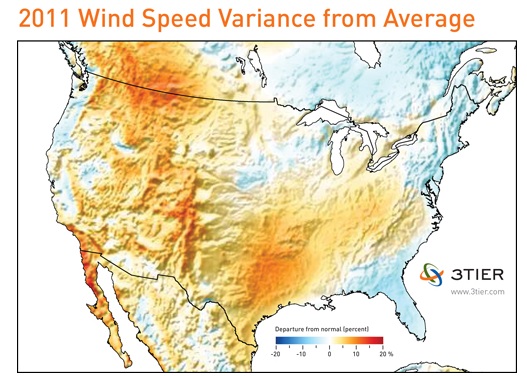A recent map of wind performance throughout 2011 shows that wind speeds were above their season averages for most of the U.S.

The map, from 3TIER, shows departures from long-term mean wind speeds that range from -20% to +20% and provides an indication of how wind projects should have performed relative to their long-term production average based on their location. This type of analysis enables financiers and owners to perform portfolio analysis across regions and quickly view the effects of weather anomalies on both existing and proposed investments.
For the year as a whole, the US experienced above average wind speeds, though month-to-month and regional variability were not uniformly above average across the country. The Pacific Northwest and New England saw wind speeds roughly 5% below average for the year, while a broad section of the US from northern Montana to Texas and the mid-Atlantic states enjoyed a strong wind year with wind speeds 5-15% above normal.
The year began with weak La Niña conditions and lackluster wind speeds. However, a stronger La Niña, which occurred later than initially forecasted, combined with a negative Pacific/North America (PNA) pattern led to increased wind speeds throughout the spring. Summer winds were particularly strong in the southern states, where warm and dry conditions continued under a large upper-level ridge that suppressed winds further north. The ridge persisted into September, when the central and eastern US moved back into a more vigorous weather pattern, with frequent frontal passages contributing to higher than normal wind speeds.
By the end of 2011 the North Atlantic Oscillation (NAO) was in a positive phase, associated with lower than normal winds in the western US. The effects of this trend dominated those of the persistent La Niña state in the equatorial Pacific. However, winds were above normal for most of the country east of the Rocky Mountains, except in the northeastern US, where upper-level ridging kept temperatures warm and wind speeds low.
The wind performance map was created by comparing output from 3TIER’s continually updated meteorological dataset with wind conditions averaged over the period 1969-2008 from the same dataset. Wind speed values were computed using a numerical weather prediction (NWP) model run at a 15 km resolution and adjusted using available observations. The underlying datasets for 3TIER’s wind performance maps provide clients with operational intelligence for every location within a region and are available in nearly all regions worldwide.
Filed Under: News




